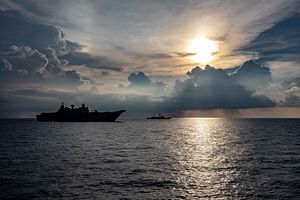After consolidating Australia’s growing security cooperation with India in April with the AUSINDEX naval exercises, the Indo-Pacific Endeavor, Canberra’s flagship 11-week regional naval deployment, made its way to Vietnam. Two vessels from the deployment — HMAS Canberra and HMAS Newcastle — docked in Cam Ranh Bay last week for a four day visit, conducting a series of engagement activities and training exercises with Vietnamese counterparts aimed at strengthening security ties between the two countries.
This was the first time that the Indo-Pacific Endeavor — now in its third iteration — has included Vietnam, a sign of growing engagement between Canberra and Hanoi, and demonstrating Australia’s willingness to commit to the strategic objectives of its 2016 Defense White Paper to enhance its partnerships with other regional security forces. In November 2018 the two countries signed a Joint Vision Statement on Further Defense Cooperation at the now annual Defense Ministers’ meeting, which followed on from an upgrading of the bilateral relationship to a strategic partnership in March 2018.
The upgrading of security relations, and last week’s demonstration of naval cooperation, reflects the recognition of a mutual broad strategic outlook for the two countries in the Indo-Pacific. Due to its competing maritime claims with China in the South China Sea (or the East Sea, as Hanoi refers to it), Vietnam has repeatedly requested that China remove its military hardware from the region, and has been pushing for a pact between ASEAN and Beijing that would outlaw much of China’s activity. The prospect of a Chinese naval base in Cambodia — which would effectively encircle Vietnam — would undoubtedly be another serious concern to the Vietnamese.
Due to these developments, Vietnam has been rapidly consolidating its security relationships with the region’s major actors, who are also wary of China ambitions. Alongside the recent security upgrade with Australia, Vietnam has also consolidated its strategic partnership with India, as well as with Japan. And most notably, last year a U.S. supercarrier, the USS Carl Vinson, anchored off the coast of Da Nang for four days in a demonstration that, in the face of shifting regional dynamics, converging strategic interests between the United States and Vietnam will begin to carry greater weight than historic animosities.
Despite not sharing the same political ideology as these four maritime-capable democracies, shared concerns about China’s growing assertiveness in the region has enabled Vietnam to find a common cause. For the countries of “the Quad,” Vietnam is generally seen to be governed by responsible stakeholders keen to uphold international laws and norms, which indicates there is a strategic role for Hanoi in the free and open Indo-Pacific strategy that was initially outlined by Japan’s Shinzo Abe in a speech to the Indian Parliament 2007 (then resuscitated in 2012), subsequently adopted by Washington, and implicitly endorsed by Canberra.
Indeed, Hanoi’s active security engagement of these four countries can be viewed as an endorsement of the concept of the Quad. Should any direct new security architecture evolve from the initial tentative discussions that have taken place, Vietnam would be broadly supportive, seeing its potential to provide a maintenance of current maritime rules and norms in the face of the shifting regional balance of power.
With these changing dynamics in mind, Canberra seems to be showing a greater commitment to playing a more prominent role in the region. Beyond the maintenance of maritime norms, there are direct economic interests to consider. Vietnam has become a growing trade partner for Australia in recent decades, with two-way trade having grown from a tiny $32.3 million in 1990 to around$9 billion in 2017. There are also considerable people-to-people links, with close to 300,000 people in Australia having Vietnamese ancestry, providing an emotional link to the country alongside the financial and strategic connections.
More broadly the increased defense cooperation with Vietnam can be viewed as part of a wider engagement with a number Southeast Asian states, reflecting an acknowledgement of the contested nature of the region, and a desire for Australia to contribute to its security architecture. The Indo-Pacific Endeavor’s current iteration has also visited Malaysia and Thailand, where Australia has long-standing defense cooperation agreements, and will make its way to Indonesia, where security ties are developing.
The Indo-Pacific has a number of rapidly developing powers like Vietnam, making the region’s increased capabilities not solely limited to China. Coordination among these other developing (and developed) powers has the potential to be able to act as force multipliers to provide enough deterrence to maintain maritime norms in the face of China’s challenging behavior. These emerging challenges have brought Australia’s interests and objectives into clearer focus and, as on display with this year’s Indo-Pacific Endeavor, provided the impetus to identify who shares these interests and objectives, and how they can be best coordinated.
































